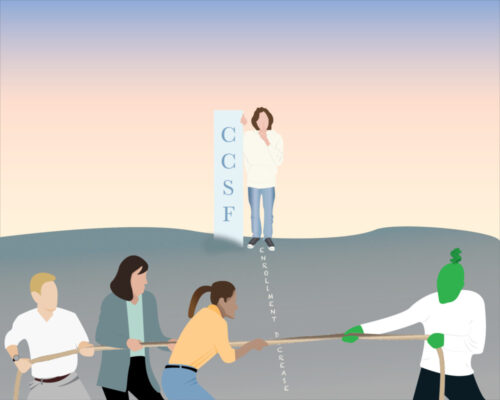Early Statistics Show Sharp Drop in Student Enrollment
By Tobin Jones
The COVID-19 pandemic and its consequences have resulted in a significant decrease in enrollment at City College, according to statistics released by the school. Preliminary findings released last month show a 18% decline in the number of students signed up for classes during the Fall 2020 semester when compared to 2019.
A National Trend
Representatives for the college stressed that the numbers are subject to change as the term progresses and students drop units or sign up for mid-semester courses. But they appear to be consistent with the wider picture emerging across the country. Data collected by the National Student Clearinghouse Research Center showed a seven percent nationwide drop in enrollment from Summer 2019 to Summer 2020.
The decline is especially pronounced among lower-income populations. Working class African-American students and those attending institutions in predominantly rural areas have withdrawn or cancelled plans to start school at particularly high rates, according to the study.
This apparent exodus of disadvantaged students serves to highlight the exceptional nature of the current economic downturn. Historically, community colleges have seen increased attendance during periods of recession, as struggling workers return to school as a way to gain an edge in a weak job market. Indeed, in the weeks that followed the initial move off campus, when most anticipated a return to in-person classes by the end of the semester, many expressed concern that City College’s resources would be overwhelmed by an influx of new registrants.
“We argued at the time that there would be an increase in enrollment,” said Vick Van Chung, recently elected to the Student Trustee position, “Because individuals would become unemployed, and with that they would like to come back into school to, you know, gain another certificate during this time to give them a little bit of leverage when the job market reopened. That has proven to not necessarily be true.”
A US Census survey of households with a minimum of one adult who cancelled plans to attend an institution of higher education found the most common reason given to be the shift to remote instruction. Low-income students, who make up a larger share of those enrolled at community and junior colleges than four year institutions, often find themselves on the wrong side of a digital divide that, even before the pandemic, had contributed to inequality in educational outcomes.

Some of students who did not reenroll this term expressed a lack of confidence in their ability to effectively learn in an online context. This was one reason that Ron Pettway, an audio production major, gave for deciding not to register for Fall classes. “As a recording student, it would be more helpful to be in the booth to learn how to use the Trident,” a sound recording console. Even if students had access to the console itself, he said, the experience of having an instructor in the room to walk them through the device’s operation was irreplaceable. “It’s no use to be able to get behind the (console) if you don’t know what you’re doing.”
A certain amount of difficulty was likely inevitable, given the sudden and unpredictable nature of the pandemic. But deep cuts made in recent years to student services have likely exacerbated the problems. Dayna Holtz, a City College librarian who also serves as the Secretary of the Associated Federation of Teachers Local 2121, which represents faculty at the school. She told the Guardsman that layoffs and hours-reductions in the Library department have resulted in “Reduced support for students trying to navigate the crisis-online learning environment,” and that because of this, “Students struggle not only to figure out our wonky course technology, but the library resources we can offer remotely to fulfill assignments.”
When added to the already considerable struggles faced by pupils from working-class backgrounds in 2020, the challenges can seem insurmountable. Van Chung, who had been living in what they described as an abusive living situation, found themselves forced to secure new housing once the shelter-in-place order made staying at their home untenable. The expense of moving compelled them to find additional employment, which has significantly cut into the amount of time they have available for schoolwork, they said.
Van Chung believes that many other students have had similar experiences. “On top of the fact that we have to shelter in place and everything is online, you really compound all these things that are happening…There were so many barriers in place prior to the pandemic and then heightened because of the pandemic, that we now see a reduction in enrollment.”
The long-term effects of this reduction remain unclear. Under a new formula passed by former Governor Jerry Brown, 70% of funding will be determined by student enrollment, 20% by the number of students who receive federal grants or aid, and 10% will be contingent on how many earn a degree, transfer to a four-year institution, or complete a certificate program. Because of a provision designed to allow colleges time to prepare for this shift, colleges will not see cuts due to reduced enrollment until at least 2023. Nevertheless, concerns remain that the downward trend in enrollment may continue, and that barring a further extension of the provision, City College and other institutions across the state could face the prospect of serious funding decreases in the future.
Holz, who describes the situation at City College as “dire,” said that cuts were antithetical to the mission of keeping the school from continuing to hemorrhage students. “We need more support, not less, for students as we dehumanize the learning experience.”
